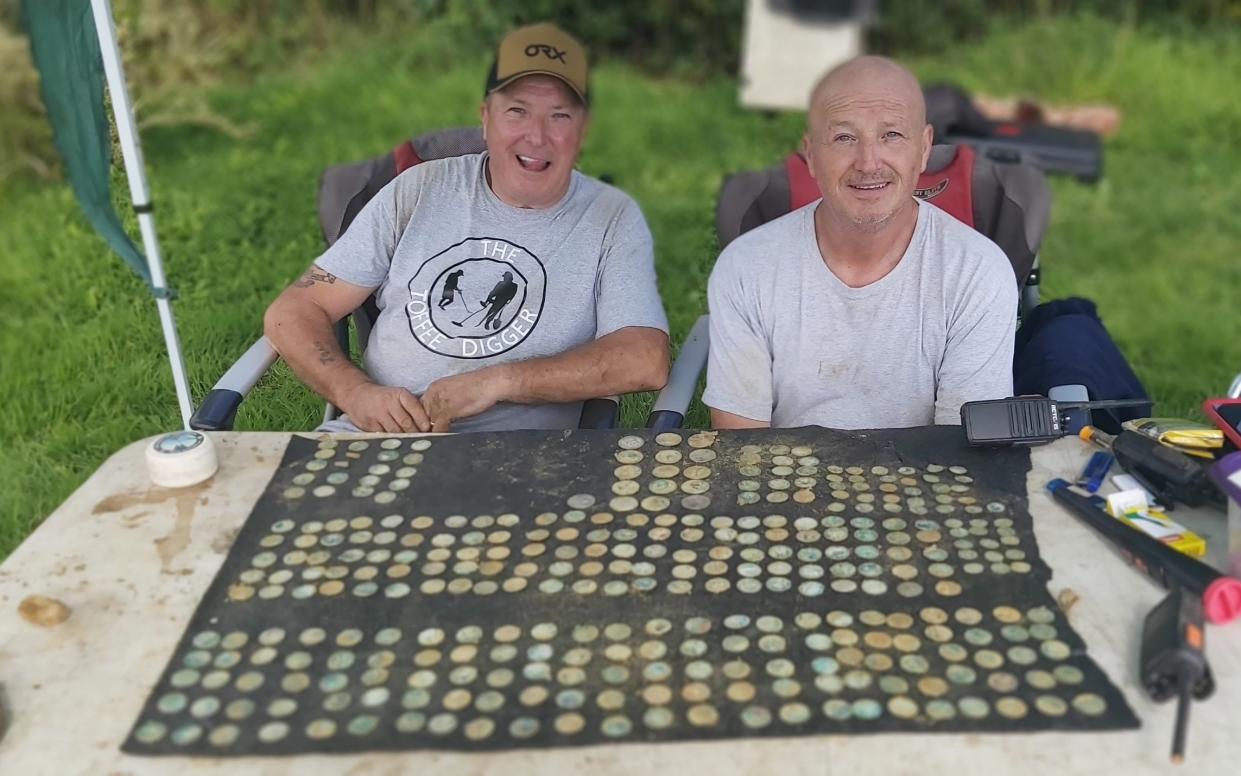Novice metal detectorist unearths Britain’s largest haul of forged coins buried 220 years ago

A novice metal detectorist has discovered Britain's largest ever hoard of forged coins that were buried 220 years ago by a notorious criminal.
John McGimpsey, 64, unearthed the 332 fake silver coins in a field in Leek, Staffordshire.
Research revealed they were buried in 1801 by forger George Fearns in a bid to hide the proof of his crimes. He had been caught passing forged notes to two undercover policemen during a sting operation at a pub.
It is believed that Fearns, who lived in a 16th century stone-walled house 200 yards from the field, buried the coins while he was being investigated for his forgeries.
Although the stash remained unfound for two centuries, the police still had enough evidence to prosecute him and he was hanged at Stafford Gaol in 1801.
Mr McGimpsey, who only took up metal detecting during the first lockdown along with his four brothers, found the coins buried 10ins down.
The 332 half crowns, shillings and sixpences had the bust of King William III on one side and King George II on the reverse.
The hoard appears to have been wrapped in old bank notes, as a tiny fragment of paper was found which has been sent for analysis.

The previous record haul of forged coins is 92, which is now in the British Museum.
Mr McGimpsey, a scriptwriter from Merseyside, contacted the local Finds Liaison Officer to inform them of his discovery and also alerted the landowner, an equestrian centre.
The hoard has been declared as treasure under the Treasure Act 1996 and is being catalogued.
He said the British Museum and Hanley Museum, which is a few miles from the find, had both shown an interest in acquiring the hoard, with the proceeds of the eventual sale to be split between him and the landowner.
Mr McGimpsey said: “I picked up a signal between two trees and dug down 10 inches. I had pretty much given up when I spotted a small disc-shaped object at the bottom of the hole. I flicked it with my finger, only to discover it was attached to ten other similar sized discs - they were all coins. The coins just kept on coming and some were even still wrapped in paper.”
He called colleague Tony Cummins, a seasoned detectorist and member of the Midland Detecting Days Club.
He drove to the spot and helped Mr McGimpsey carry on looking.
‘This discovery was sheer luck’
Mr McGimpsey said: “Finding yet more coins, we finally placed them all into a rucksack and laid them out on the finds table. I was amazed by the total. Most were very toasted and a close initial examination revealed that many, if not all of them, appeared to be forgeries.
“Then Tony noticed something really strange - the coins all depicted the busts of William III but the reverses were all of George II and dated 1746.”
He added: “We are five brothers who only started detecting at the beginning of lockdown and this discovery was sheer luck.
“As far as we know, the coins were forged by George Fearns who was convicted of possessing forged notes, but was never caught with any of his coins.
“Before now, the largest forged coins hoard discovered was 92 which is in the British Museum, so this is much larger than that.
“It seems like Fearns for trying to hide the evidence and the hoard's location, between two distinctive trees, suggests he had hoped to retrieve them, but never got the chance.
“It is amazing to think they have been in the ground for 220 years, and it appears they were wrapped in old bank notes.
“I believe the British Museum and Hanley Museum are interested in acquiring them, but it is a long process and I hadn't been told their value yet."

Julian Evan-Hart, editor of Treasure Hunting magazine, said it was an ‘amazing’ discovery which had more 'historical than monetary value'.
He said: “It is one of those classic metal detecting discoveries and you do wonder if there are other deposits still there which were buried in haste.
“It appears George Fearns was trying to hide the evidence as quickly as possible as it is not a good idea to do it near your house.
“It is very strange that there are busts of two kings 100 years apart on the coin - perhaps he was going to use the excuse they were gaming counters.
“This is an amazing discovery which has far more historical significance than cash remuneration value as at the end of the day they are forged coins.”

